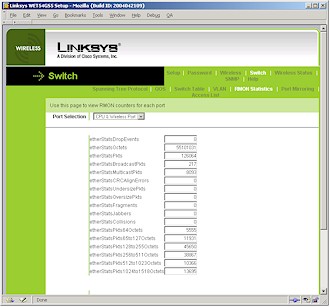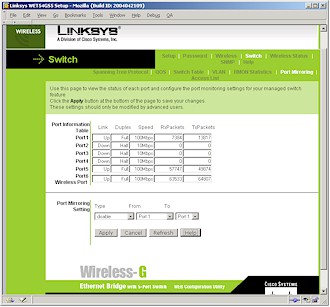Other Switch Features
The Marvell switch chip gives the GS5 plenty of other managed switch capabilities normally seen in products costing about twice as much. Experienced networkers may find more use for some of these features than newbies, but don't let that stop you from exploring them. But I'll warn you that playing with some of them and not knowing what you're doing can mess you up enough to require hitting the ol' reset-to-defaults button.
Enabling the Spanning Tree Protocol (STP) feature (off by default) allows the GS5 to be used in redundancy applications and larger network configurations. Linksys provides global controls for Maximum Age, Hello Time and Forward Delay and per-port control of Priority and Cost and readout of STP State. The User Guide and on-line Help provide a little helpful information about each control, but again, not enough to help you to really understand how to use them.
TIP: This O'Reilly article can help you get up to speed on STP.
The RMON Statistics page (Figure 6) provides more than you'll probably need to know about the low-level Ethernet statistics of each port. But the nice thing is that you can remotely check each port to see if traffic is flowing.

Figure 6: RMON stats
(click on the image for a larger view)
TIP: RMON is actually a spec implemented by many enterprise-level networking products. Learn more from this whatis definition and Cisco article.
If you've ever tried to run a network protocol analyzer (or "sniffer") such as the free, Open Source Ethereal, you've probably discovered that you can only see the traffic for the machine that the analyzer is running on and not other devices plugged into a switch. One solution to this problem is to dig up an old network hub, which sends data received on any port to all other ports.
The preferred solution, however, is to use a switch with Port Mirroring capability (Figure 7), which is precisely what the GS5 provides. The GS5's controls enable you to copy traffic from the From Port that contains the device you want to monitor to the To Port where you would connect your network analyzer.
The feature is disabled by default, but can be set to Monitor egress (traffic exiting the From Port) or Monitor both (traffic in and out of the From Port).

Figure 7: Port Mirroring
(click on the image for a larger view)
The top part of the page contains a handy at-a-glance status board for all the GS5's ports, too. This is one case in which a programmable page auto-refresh would have been handy for continuous monitoring of the GS5's status.